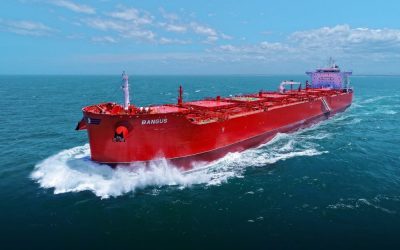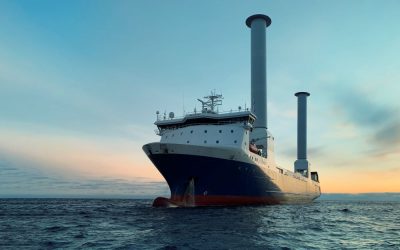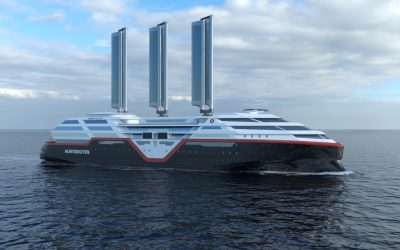Jan Ole Huseby, head of Global Ocean Industries at Norway-based DNB, one of the world’s leading ‘ocean space’ banks, discusses the role of finance in enabling the sustainable transition the maritime industry so desperately demands
“There’s a gap between ambition and reality at present, and if we don’t work to bridge that divide we face a grave challenge.”
Jan Ole Huseby, DNB’s head of Global Ocean Industries, is giving a sober assessment of the “incredibly capital intensive” nature of the energy transition necessary in facilitating a truly sustainable future. Referring to findings from the International Energy Agency (IEA), he points out that annual investments in clean energy need to reach US$4.4 trillion in 2030 (falling to US$4.1 trillion by 2050). Putting that into perspective, the average annual investment between 2016 and 2021 was US$1.2 trillion.
“There’s a need for massive investment to transform the ocean industries, both here in Norway and across the world,” he says, singling out offshore wind and carbon capture and storage as examples of key ‘cash hungry’ development areas.
“But, as we can see when we look at capital markets over the last year, uncertainties – ranging from geopolitics and macroeconomics through to questions about which fuels and solutions to invest in – can narrow opportunities to raise funds. So, it is, to say the least, complex.”
But, as quickly becomes evident, he’s far from disheartened by the challenge.
Firstly, Huseby says the capital hurdles are just that – hurdles rather than permanent blocks – pointing to the fact that DNB has already handled numerous “large bond transactions” this year. Secondly, he argues that a collective approach, across the ocean industries and beyond, can help enable an evolution that, at heart, everyone requires for a profitable, sustainable future.
“We all have a role to play,” he states, “and DNB is determined to play its. We want to help finance the future, in partnership with clients worldwide.”
Supporting progress
DNB has taken care to position itself at the heart of shipping’s sustainable charge, while seizing opportunity within rapidly growing ocean industry segments. Offshore wind is a prime example of the latter point, with the Oslo-headquartered institution providing over US$2 billion in funding to the offshore wind service segment over the last two to three years, cementing its place as number one lender within the niche.
“We don’t want to take a ‘watch and wait’ approach,” Huseby notes. “It’s our ambition to assume a leading role; exercising a positive influence where we can, building understanding to be a better partner and advisor for clients, and helping accelerate the transition. There’s many ways we can contribute here.”
Indeed there are – the list he gives is comprehensive. Looking at an industry-wide perspective first, DNB was one of the founding banks in the launch of the Poseidon Principles, the lauded framework for integrating climate considerations into maritime lending decisions. It was also an early mover in supporting the Responsible Ship Recycling Standards (RSRS), introducing requirements relating to ship recycling in all its loan agreements. In addition, DNB is an active member of the Getting to Zero Coalition, focusing on the development and deployment of zero-emission deep-sea vessels, and is working on pilots relating to green technology and sustainable financing with the Norwegian Green Shipping Programme.
But, of course, it’s in its everyday lending activities where the bank can make the biggest impact, helping its clients with an approach involving both carrot and stick.
The business of change
“We have our own goal of reducing the carbon intensity of our shipping portfolio by a third from 2019 to 2030, which is beyond the scope of current industry targets,” Huseby states. “So, we need to help our clients meet their goals to meet ours.”
As such, sustainability considerations play a growing part in client selection, he says, with assessments based on criteria such as regulatory risk, fleet renewal plans, long-term transition ambitions, and general climate objectives.
“We want to partner with responsible businesses who are working towards the same goals as we are, and that approach feeds into every lending decision,” he adds. “Sub-standard practices will not be accepted.”
On the carrot front, DNB has been active in developing and marketing sustainably linked loans and bonds and arranged the first sustainability linked bond in shipping, issued by Odfjell SE in 2021. Since then, many more have followed.
“We want to show the opportunity here,” Huseby smiles. “Going green isn’t just about the environmental gains, it should make good business sense!”
Fresh perspectives
With a lack of silver bullet solutions for fuelling that green voyage, DNB has established its own in-house Energy Transition Solutions function within Ocean Industries, building insight and know-how on the latest innovations, technology and sustainable finance solutions across all the maritime industries.
It’s all part of what Huseby calls “active engagement” to better understand, and advise upon, challenges and opportunities.
“There’s as many opinions as shipowners out there,” he laughs, adding with a more serious tone: “So I think the industry needs a flexible approach – as we can already manifesting itself in the growing orders for dual-fuel vessels – and help with assessments of low- and zero-emissions technology from a financial perspective, building good business cases for adoption. We’re here to help in that respect.”
Huseby says that with so many solutions on, and emerging from, the “drawing board” – and the need for different solutions for different vessels and trades – DNB has yet to fund many breakthrough alternative fuel vessel projects. However, the bank is following numerous developments with interest (Huseby mentions sails and ammonia specifically) and actively helping clients with funding for optimising existing fleets.
“There’s so much that can be done today,” he comments, “and we’re really encouraged to see the action that our clients and partners are taking. There’s real commitment out there.”






